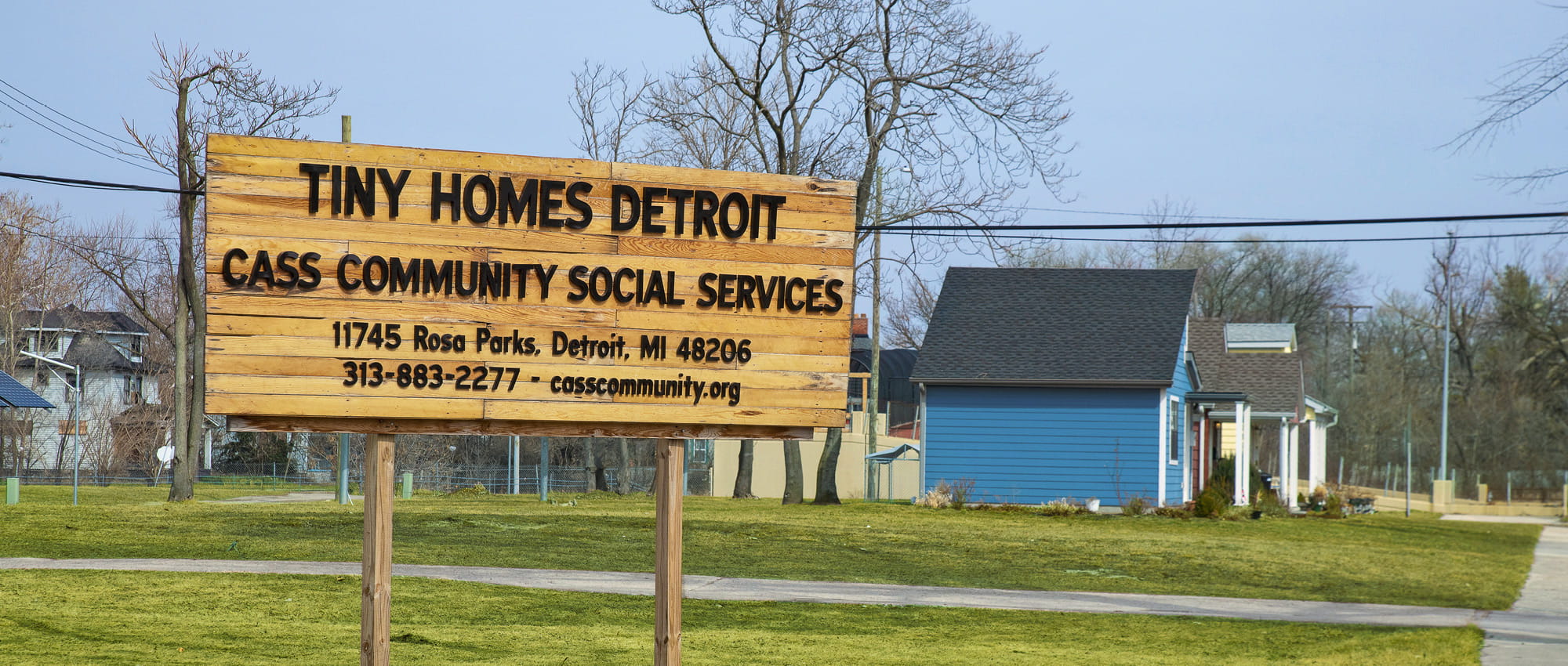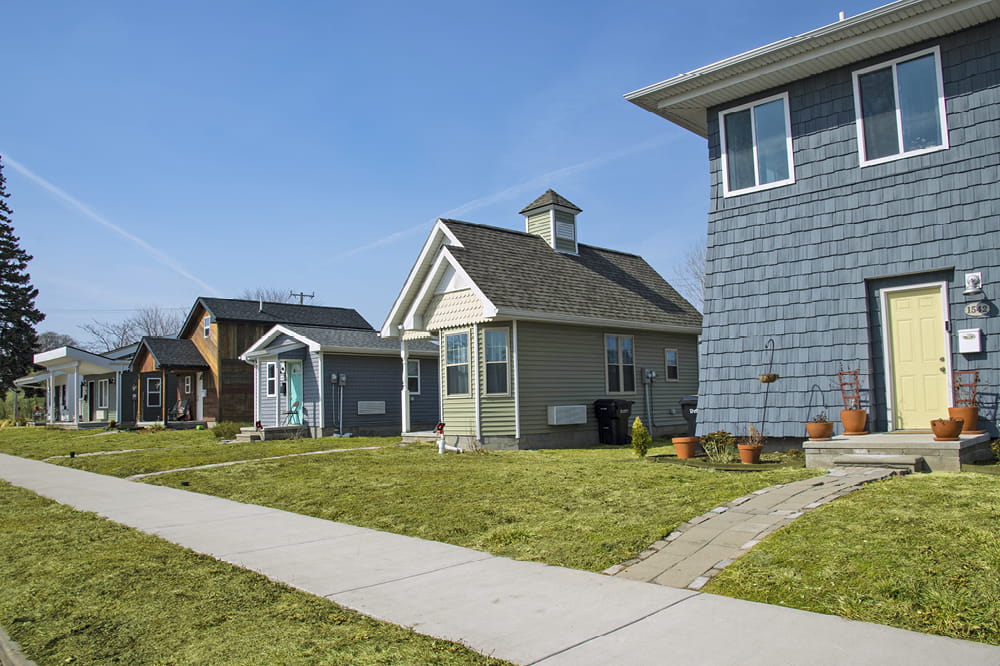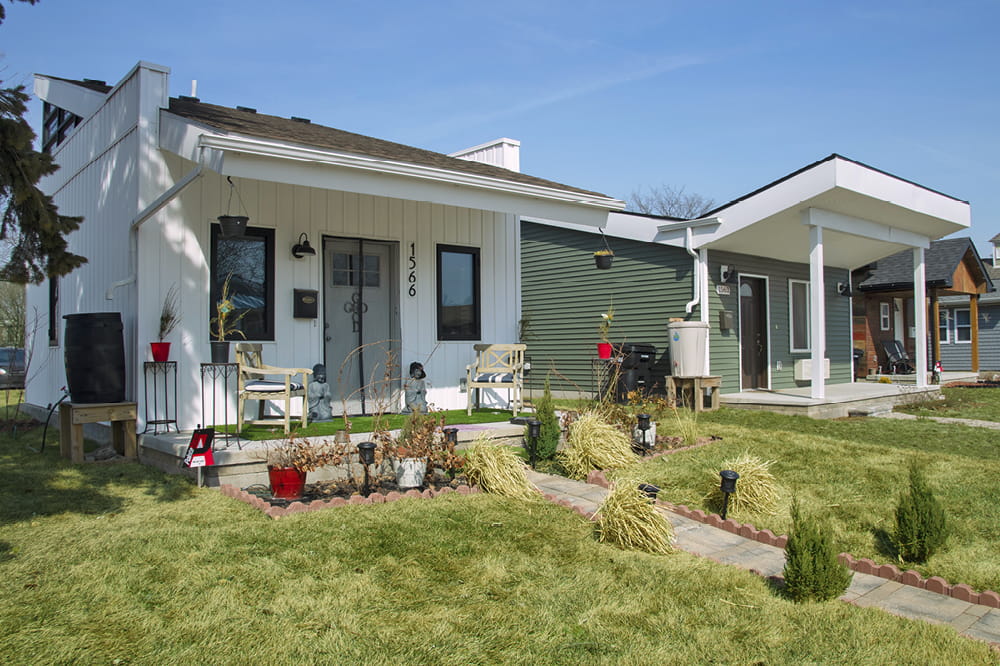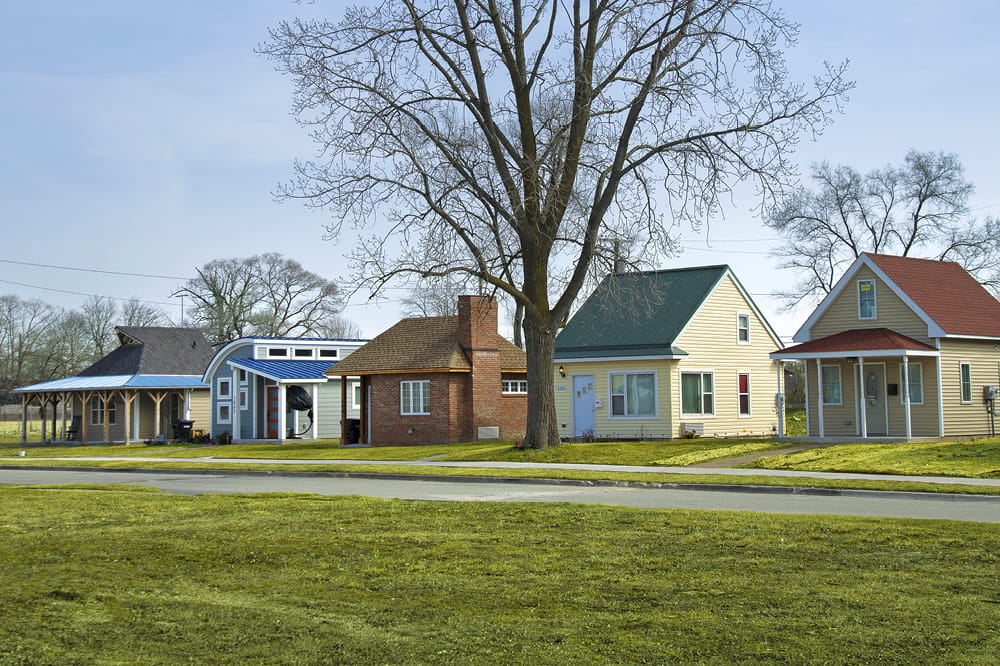Obtain news and background information about sealing technology, get in touch with innovative products – subscribe to the free e-mail newsletter.

22.06.2021 | Story
Tiny House, Huge Impact
Thirty miles east of Freudenberg Sealing Technologies’ North American headquarters in Plymouth, an innovative approach to home ownership for homeless and low-income individuals has emerged in Detroit. It is an approach that promotes sustainability on a social level and demonstrates how to deal creatively with scarce resources such as space.
In a blighted corner of the city, tucked between the Lodge Freeway and Woodrow Wilson Street, a collection of tiny houses has been built. At 400 square feet or less in size, these homes are small by American standards. But what they lack in size, they make up for with clever creativity and an unprecedented rent-to-own formula that can transform their occupants from renters to homeowners in a mere seven years. Nineteen little jewels already grace the Cass Community Tiny Homes Neighborhood. An additional six will be added this summer. Each tiny dwelling is a unique blend of architectural styles, building materials and colors. Despite their diminutive proportions, the fully-furnished houses have a kitchen, a bathroom, a bedroom and sitting area. They include front porches or decks to expand living space, and storage is tucked into every conceivable corner. Cathedral ceilings make them feel bigger.
These homes are also eco-friendly. They run on electricity and generate power with solar panels. They use rainwater capture systems to recycle water. Doors, windows and insulation have top energy ratings. High-efficiency air conditioners keep them cool in summer. And they promote sustainability on an entirely different level – helping disenfranchised individuals integrate into society in a tangible, long-term way.
Homeless in a City of Homes
A recent U.S. Housing and Urban Development report noted that on any given night in Detroit, more than 1,500 people are homeless, including seniors, the disabled, veterans and youth. More than 220,000 of the city’s 675,000 residents are classified as low-income. The cycle of poverty that ensnares them is all too familiar to Reverend Faith Fowler, executive director of Cass Community Social Services (CCSS). CCSS has been providing temporary housing, meals, health care access and job training to city’s homeless and poor for decades. Despite this important assistance, Fowler realized there was more to do. “Homeless and low-income people lack assets – a home, a car and possessions, for example,” Fowler said. “Without these assets, they can’t get a loan, and they don’t qualify for a mortgage. So we were helping these people get by, but we weren’t helping them get ahead.”
Unable to raise the incomes of the city’s poorest individuals, Fowler and CCSS began exploring other ways to build their assets and opportunities. Home ownership became the focus. “We wanted to get them off of the rental treadmill,” Fowler said. “This development is intended to help men and women who have so much to contribute but who have not been able to overcome multiple economic hurdles.” It has proven to be a very big, tiny project. Detroit was once known as a city of fine, single-family homes. By the time the city declared bankruptcy in 2013, neighborhoods had collapsed and more than tens of thousands of homes were left vacant and rotting. The Center for Community Progress reports that progress to raze the blighted structures has been slow; as of September 2020, more than 102,000 derelict homes remained standing. Despite the renaissance that the city’s midtown and downtown districts are enjoying, the city’s neighborhoods remain largely untouched by reinvestment and rebirth. Affordable housing for the very poor is a constant challenge – but one that Fowler, CCSS and a veritable army of volunteers and contributors is tackling, tiny house by tiny house.
Tiny houses in the U.S.

Driven by necessity, convenience or both, people throughout history have lived in very small spaces. Here are some examples:
- During the Great Depression of the 1930s, tent and shack "cities" sprang up across the U.S.
- Government and agencies use tiny structures to house people impacted by natural disasters.
- Tiny house villages have been developed in cities across the country to provide temporary shelter to low-income and poor people.
- Tiny houses have also become a more popular movement, providing creative living quarters to a generation of individuals who are inspired by the idea of "less is more" and who reject the trend towards huge homes.
Tiny Houses, a Big Idea
Fowler’s personal interest in the tiny house movement coincided with the agency’s push to develop a program to break the cycle of poverty in Detroit. But unlike other tiny house communities she had seen, she wanted home ownership to be part of the package. “We are the first program in the country to link affordable housing with home ownership for homeless and low-income individuals,” Fowler said. “There just wasn’t enough affordable housing in Detroit for the poor. Even if they had a job or source of income, they could not qualify for a loan. With no access to resources, poor people were segregated from neighborhoods. When you are segregated, you are stigmatized. The tiny homes that Cass Community Social Services created were meant to build a neighborhood, renew the area and end the stigma.”
When Fowler and CCSS unveiled the Tiny Homes Program in 2016, it was met with a groundswell of support. The CCSS concept was unique: Rather than build temporary housing for homeless and low-income people, the agency would build homes and homeowners through a novel rent-to-own approach.
Raising Houses, Making Noise
Each tiny dwelling in the neighborhood would rent for $1 per square foot – an amount that ensured no house would cost more than $400 a month. Renters would be chosen based on their backgrounds and commitment to the program. They needed a source of income to pay their rent and bills. They must attend monthly home maintenance and budgeting classes. They were required to join the new neighborhood homeowners association and follow its governance rules. They had to volunteer at CCSS once a month. And they had to become part of the neighborhood, offering help and support to their fellow residents whenever they could. In return for a seven-year commitment to these obligations, each tiny house renter would become a homeowner, and the lot and the house would be deeded to them. They would gain both a valuable asset and a means for leaving poverty behind. Fowler and CCSS volunteers introduced the idea to businesses, churches and other service agencies to start raising money for construction. Corporations, charitable foundations, schools, builders and individuals like musician Jon Bon Jovi, stepped forward to donate money, materials, talent, furnishings and employee volunteers to make the program a reality. Professional tradesmen were used to lay foundations, build framing and plumb and wire the homes. Everything else was handled by volunteers.
The Program Praised Around the World
When Jeffrey Hayes arrived in Detroit, he wasn’t necessarily looking for a house. Hayes was on a quest. After living homeless on the streets of Philadelphia for a “very long time,” Hayes, who had grown up in foster care, heard his birth mother and brother were living in Detroit. Hayes traveled to the Motor City, only to find that his mother had died and his brother was sick with cancer. He needed a plan that didn’t involve returning to the streets to live. Hayes initially lived with his brother and found a job sorting stock in a warehouse. He heard about the Cass Community Tiny Homes program and filled out an application. Just when his living arrangements were crumbling, he was notified by CCSS that he had been approved for a tiny home. He moved into the house in 2017 and has lived there ever since. Hayes has never owned a home, has never even dreamed about the possibility. Now, with ownership just three years away, he cannot thank God, CCSS and his neighbors often enough.
I have my own house to live in, and I live near CCSS where meals and a gym and a medical clinic are available.
Jeffrey Hayes, Member of Cass Community Tiny Homes Neighborhood
“This program is testimony to the goodness and grace of God and Rev. Fowler,” Hayes said. “I have my own house to live in, and I live near CCSS where meals and a gym and a medical clinic are available. I don’t pay a gas bill, and the solar panel offsets my electric bill. I live in a community and even do security for all of the tiny homes. I am totally blessed and want to give back in any way I can.” Word about the Cass Community Tiny Homes program has spread. Thousands of visitors have driven through the neighborhood since its establishment, many of them officials from other agencies, other cities and even other countries. Fowler is routinely asked to make tiny house presentations and share the process she and CCSS followed to make the program a Detroit success. Several cities across the country have launched similar programs, adopting the goal of homeownership for the poor as their vision of social change. Fowler, ever an inspired pastor who seeks social change and renewal in Detroit, has already established plans to launch a green business district near the Tiny Homes neighborhood to provide access to shopping and jobs. The agency will also begin construction of 10 family houses in the vicinity using the same rent-to-own formula that has brought such success. “We wanted to provide a springboard for folks making as little as $9,000 a year for whom the American Dream was elusive at best,” Fowler noted. “We are convinced that facilitating their escape from poverty … will have a positive impact on generations to come.” Time will tell, but nonetheless, a job well done in Detroit.
The current issue of our corporate magazine ESSENTIAL deals with resource scarcity and how to cope with it. The example of the lack of (affordable) housing mentioned here is just one resource issue of many in society and industry. Click here to read the issue.
More news on the subject Sustainability

Join Us!
Experience Freudenberg Sealing Technologies, its products and service offerings in text and videos, network with colleagues and stakeholders, and make valuable business contacts.
Connect on LinkedIn! open_in_new










